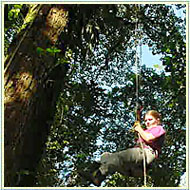Bringing the Research Home
Our last evening at La Selva, Lee gave a summary talk. We were surprised (and happy) to find out that we had collected about 1,000 caterpillars representing 74 different species. Of these, at least six of the caterpillars were new to Lee and Grant and this will be the first time they will rear these species to adulthood. The data from these caterpillars will help them to predict which parasitoids will be more likely to attack which caterpillars. It will also give them new information about caterpillar defenses and add to their natural history database. This was great to hear because on some of our collecting trips into the primary forest, we only found 8 to 12 caterpillars!
So why is this important? One practical application is control of agricultural pests. Caterpillars damage many commercial crops such as bananas in Costa Rica. If enough is known about the specific parasitoids that attack and kill certain species of caterpillars, these parasitoids could be used to control the number of caterpillars.
This type of biological control usually involves introducing a natural enemy that will eat the pest that you need to control. Since not enough is known about how the pest organisms and their predators interact, the biological control of agricultural pests has not always been successful and most farmers have relied mainly on chemical pesticides. Pesticide use has caused problems all over the world and successful biological control could offer a more environmentally-friendly way to control agricultural pests.
 |
 |
 |

Tree climbing with ropes was one of the many new skills I learned in the rain forest. Lee and Grant, however, no longer use this as a regular method to collect caterpillars.
|
 |
 |
 |
Secondly, there is an increasing concern all over the world about the importance of tropical rain forests and the need to save them. While this is a complicated issue involving not just science but the economy and politics of the countries involved, a basic scientific understanding of what these forests contain and how they work is essential for all conservation efforts. This project supplies another piece of the puzzle by documenting the natural history of numerous species of moths and butterflies. Furthermore, this information is available on-line for anyone who wishes to use it for other studies or for education!
Finally, tropical rain forests are world treasures and the responsibility for their preservation lies not only with the people living in or near them but with all world citizens. Decisions you and I from the developed countries make about what goods we buy and how much energy we use eventually impact the future of these forests. If we are to work to save them, we first need to understand them and to understand them, we need to know about them. This project should make us all appreciate the importance of even some of the smallest members of the rainforest — the caterpillars!

